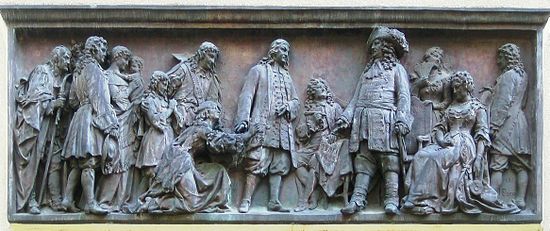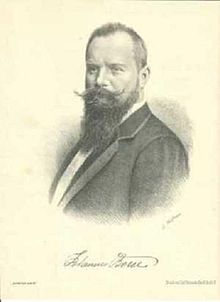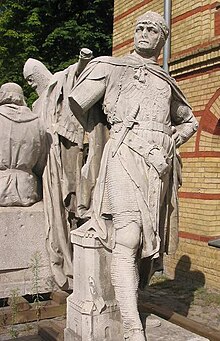Johannes Boese (sculptor)
Johannes Boese , also Johannes Böse , (born December 27, 1856 in Ostrog , Ratibor district , † April 20, 1917 in Berlin ) was a German sculptor , medalist and university professor .
Johannes Boese stood in the tradition of the smoking school and is considered a representative of moderate naturalism . He made a name for himself in 1888 with the war memorial "Flag Bearer" on the New Garrison Cemetery in today's Berlin-Neukölln , which is considered his main work. He also became known through a group of monuments for Berlin's Siegesallee . In addition to his artistic activity, Johannes Boese was involved in association politics. As a professor , he taught at the Berlin Art Academy .
Life and artistic development
Johannes Boese was a trained wood carver . After completing his training, he attended the trade school in Gleiwitz . In 1877 he entered the Berlin Art Academy, where he studied sculpture with Albert Wolff and Fritz Schaper until 1883 . In 1883 he became a master student of Albert Wolff, who was one of the leading representatives of the smoking school within the Berlin sculpture school .
According to Uta Lehnert, Boese aspired to be a craftsman or architect . In his first creative period he mainly created handicraft sculptures and tried to get to the art of architecture through these works - such as the clock in the large hall of the office building of the "Great Berlin Tram Company". He stuck to this professional goal even after his first major success with the work "Narcissus" from 1883, which was awarded at the 1888 World Exhibition in Melbourne . Only after the recognition he received for the war memorial in the garrison cemetery and after winning other competitions, Boese decided on monumental sculpture in the early 1890s.
In 1887 Boese had created the statuette “Kaiser Wilhelm I with the reading magnifier”, a work that introduced him to the future Kaiser and which opened the door for him to further orders. Kaiser Wilhelm II acquired the statuette for his private apartment and gave away several replicas, among others to Helmuth Karl Bernhard von Moltke and Bernhard von Bülow . Boese was awarded the contract for the Fischerbrückendenkmal ( Albrecht the Bear , 1894) at the express request of the Emperor, although Reinhold Felderhoff had presented a much-noticed model for the monument. One of the highly sought-after jobs for the Siegesallee among sculptors for financial reasons came to Boese without an application, unlike most artist colleagues.

In 1895 Boese was one of the ten award-winning sculptors in the Sprea competition . The Berlin magistrate had announced the competition in order to symbolize and personify the Spree with a marble statue in the vestibule of the magistrate's meeting room in the Berlin city hall ; the contract for the work was ultimately awarded to Jeremias Christensen .
For the monument to Emperor Friedrich III erected in Posen in 1902 . Boese received the title of professor at the Berlin Art Academy. The sculptor Georg Meyer-Steglitz was one of his students . Boese was a member of the Association for the History of Berlin and the Association of Berlin Artists (VBK). At the beginning of the 1890s he was a member of the board of directors of the sculptors' association of the Berlin Art Cooperative . In 1899 the Society of Fine Artists (GBK) appointed him to its exhibition committee. In addition, Boese was a member of the literary society "Sammetbrüder". He was a bearer of the Prussian Red Eagle Order IV class . He found his final resting place in Friedrichshain's Georgen-Parochial-Friedhof II .
According to von Lehnert, the contemporary art critic Max Rapsilber saw classical calm and Hellenic symmetry unconsciously inspired by Germanic realism and modern mood in Boese's works . Lehnert characterizes the sculptor as a representative of moderate naturalism who did not cross the boundaries of the conventional and who also did not commit to modernism . He did not develop a personal style and his reputation remained rather insignificant in artistic circles.
plant
War memorial garrison cemetery
Boese's main work is his war memorial “Flag Bearer” from 1888 in today's Columbiadamm cemetery in Berlin-Neukölln , the former New Garrison Cemetery at Tempelhofer Park , opposite the Hasenheide park . The monument to those who died in the wars of 1866 and 1870/71 was cast in bronze by the Schäffer & Walcker fine art foundry .
In front of an obelisk as a traditional sign of victory, Boese has placed a life-size Prussian soldier with a lowered flag, who mourns his comrades who have been killed. The belt buckle of the uniform shows a crown in the middle and bears the inscription in a semicircle: God with us . At the end of the flag the two signatures are engraved: Geg. Ad Ges. Schaeffer & Walcker and J. Boese 1888 . As in many monuments to these wars, the black Prussian eagle with outstretched wings towers over the soldier . On the obelisk above the eagle there is a five-line tribute: Den fd Vaterland • d. Comrades • d. Warrior Association • Berlin • u. Neighborhood .
The back of the obelisk shows a bronze plate with a bell relief in memory of the paratroopers and lines in memory of other fallen soldiers of the Second World War .
Monument to Albrecht the Bear on the Fisherman's Bridge
In 1894 Boese created the monument for Albrecht the Bear , 1157 founder of the Mark Brandenburg and its first margrave . The statue was erected together with its counterpart, the monument to Waldemar the Great by Max Unger , on the newly built fishing bridge on Mühlendamm ; both statues are no longer there. The monument was cast in bronze and depicted Albrecht in chain armor . The work met with great applause from Kaiser Wilhelm II - the client and financier of Siegesallee - and, according to art critic Max Rapsilber, "actually gave rise to the creation of Siegesallee".
Monument group Siegesallee
Boese created monument group 4 for Siegesallee with the central statue of Albrecht II and the two secondary figures of Eike von Repgow , the author of the Sachsenspiegel , and Hermann von Salza , Grand Master of the Teutonic Order. The unveiling took place on March 22, 1898. Since no authentic portraits of Albrecht existed, Boese based his design on his monument from 1894 for Albrecht the Bear, Albrecht II's grandfather. Boese posed the fourth Margrave of Brandenburg in a theatrical pose with a mail shirt and a leg, the sword firmly in the grip, as Protector of the Mark . A contemporary depiction described the monument to the Brandenburg Margrave as follows:
“The margrave, in chain armor with his hood turned up, is seen in a combat-ready position, as he protects a castle with drawn swords, probably the border fortress of Oderberg , which was built in 1215 . The head of the energetic prince is adorned with a narrow crown ring; A wide decorative belt is looped around the weapon shirt adorned with the Brandenburg eagle, a long coat, held together by the left hand, falls down picturesquely to the back. "
Eike von Repkow modeled Boese while working on the Sachsenspiegel, the most important and, together with the Mühlhausen Imperial Law , the oldest legal book of the German Middle Ages . The sculptor captured the Grand Master of the German Order as an old, energetic man in an upright position with his left hand on his chest. The certificate in his right hand and a crown circlet pulled over the unusual balaclava refer to Salza's elevation to the rank of prince. According to Lehnert, the architecture of the destroyed pedestal had an original ornamentation of the base friezes. A shackled Turk was to commemorate Salza's participation in the Crusades. An owl and a parrot symbolized Repkow's scientific orientation and wisdom as well as his godly life. A lion's head stood for the opposing powers in Albrecht's reign. Regarding the group as a whole, Lehnert criticizes the fact that the three people are depicted without any relation and that they appear to be randomly combined. The architecture refers to the sculptor's inability to create a harmonious, coordinated niche architecture. The damaged figures have been resting in the Spandau Citadel since May 2009 .
Other works
- 1883: "Narcissus" (honored at the WA in Melbourne in 1888 )
- between 1883 and 1889: clock in the great hall of the office building of the Great Berlin Tram Company
- 1885: Relief "Reception of the Huguenots by the Great Elector" on the facade of the French Cathedral in Berlin-Mitte

- 1886: Obelisk The creators of this facility in Lennépark Frankfurt (Oder)
- 1887: Statuette "Kaiser Wilhelm I with the reading magnifier" (several replicas)
- 1888: War memorial in the Columbiadamm cemetery behind the Hasenheide in Berlin-Neukölln (see section above)
- 1888–1891: War trophies on the front of the pillars of the Moltkebrücke in Berlin-Moabit

- 1893–1894: one of the four bronze bears of the newly built Moabiter Bridge in Berlin (the others by Karl Begas , Johannes Götz and Carl Piper)
- 1894: Statue of Margrave Albrecht the Bear , Mühlendammbrücke (Fischerbrücke) in Berlin-Mitte
- 1894–1895: Statue of King Friedrich I (“at the age of his accession to the throne”), until 1950 in the White Hall of the Berlin City Palace , today in the New Palais in Potsdam
- 1896: Bust of Werner von Siemens on the vault of the Oberbaum Bridge in Berlin
- 1897–1898: Equestrian statue of Kaiser Wilhelm I on Breslauer Platz in Liegnitz ; Total height approx. 11.5 m, equestrian statue 4.60 m, cost 80,000 marks, destroyed in 1945
- 1898: Statue of Kaiser Wilhelm I in Neustadt
- 1898: Monument group 4 with the statue of Margrave Albrecht II and assistant busts to Eike von Repgow and Hermann von Salza in Siegesallee in Berlin-Tiergarten (see section above)
- 1898 ?: Portrait tondo of the actor Ernst Formes in the old cathedral cemetery of St. Hedwig's parish in Berlin-Mitte; Bronze relief disappeared
- 1900: Statue of Kaiser Wilhelm I in the Hall of Fame in (Wuppertal-) Barmen , inaugurated on October 24, 1900 by Wilhelm II, executed in Carrara marble ; The statue shows Wilhelm I with the coronation cloak in front of his throne, the right hand holds the imperial sword , the left carries the document in which his legacy and his work - the establishment of the German Empire - are recorded. The fee for Boese was 23,000 marks.
- 1900: Statue of Kaiser Wilhelm I in Brzeg
- 1901: Statue of Emperor Friedrich III. in oils
- 1902: Monument to Emperor Friedrich III. on Wilhelmplatz in Posen , unveiled on September 4, 1902; The statue represented the emperor in the uniform of a field marshal with a Hohenzollern coat thrown on. In his design, Boese had provided a peasant standing crouched at the foot of the monument, reminding of the rural character of the province of Posen and giving the emperor the traits of a gracious, accessible ruler should. Kaiser Wilhelm II prevented this detail from being carried out. For this memorial, Boese allegedly received the title of professor.
- 1903: Memorial with double relief of Kaiser Wilhelm I and Friedrich III. in Pless , in front of it an infantryman with a flag
- 1905: bronze portrait plaque for the family grave of Theodor Lobe at the Radebeul-West cemetery
- 1909: Seated statue for Joseph von Eichendorff in Ratibor , who like Boese was born there; The statue shows the poet sitting on a tree stump, one finger stuck in the book on his knees, his gaze directed into the distance. The memorial was rebuilt in 1994 with a copy by Georg Latton.
- 1910: Equestrian statue of Kaiser Wilhelm I on Stefansplatz in Stolp
- 1910: Equestrian statue of Prince Leopold von Hohenzollern-Sigmaringen on Leopoldsplatz in Sigmaringen
- 1910: Equestrian statue (half life size) of Prince Leopold von Hohenzollern-Sigmaringen in the courtyard of Namedy Castle
- 1913: Busts of Adolphus Busch and Lilly Anheuser-Busch for Höhenried Castle , in the Busch-Reisinger Museum
- 1917 (1916?): Tomb of the actress Anna Schramm in the cemeteries of the Jerusalem and New Churches in Berlin-Kreuzberg
and undated:
- various busts, among others for Albert Wolff , James Hobrecht , the Duke of Ratibor , Emil Frommel , Oskar Pintsch
literature
- Paul Kühn: Boese, Johannes . In: Ulrich Thieme , Felix Becker (Hrsg.): General Lexicon of Fine Artists from Antiquity to the Present . Founded by Ulrich Thieme and Felix Becker. tape 4 : Bida – Brevoort . Wilhelm Engelmann, Leipzig 1910, p. 206 ( Textarchiv - Internet Archive ).
- Peter Bloch, Sibylle Einholz, Jutta von Simson (eds.): Ethos & Pathos. The Berlin School of Sculpture 1786–1914. Catalog and volume accompanying the exhibition, Berlin 1990, Volume I, p. 51 f.
- Uta Lehnert: The Kaiser and the Siegesallee. Réclame Royale. Dietrich Reimer Verlag, Berlin 1998, ISBN 3-496-01189-0 .
- Peter Paret: The Berlin Secession. Modern art and its enemies in Imperial Germany. Ullstein, Frankfurt am Main 1983, ISBN 3-548-36074-2 . (= Ullstein book , vol. 36074.)
Web links
Individual evidence
- ↑ Prof. Johannes Boese. Artist. German Society for Medal Art, accessed on July 19, 2018 .
- ↑ a b c d Uta Lehnert: The Kaiser and the Siegesallee…. P. 362.
- ↑ Uta Lehnert: The Kaiser and the Siegesallee…. Pp. 362, 370.
- ↑ Mario Perschke: The "Sprea" by Jeremias Christensen. In: Mitteilungen des Verein für die Geschichte Berlins (MVGB), 92nd year, issue 1 (January 1996), pp. 172–178, here pp. 173 f. ( zlb.de PDF; 9.3 MB).
- ↑ Georg Meyer-Steglitz. In: Saar artists lexicon.
- ^ Hans-Jürgen Mende: Lexicon of Berlin tombs. Haude & Spener, Berlin 2006, ISBN 3-7759-0476-X , p. 101.
- ↑ Uta Lehnert: The Kaiser and the Siegesallee…. P. 33, 112, p. 237 Note 24. Quotation from rapsilber based on a reproduction by Lehnert. Lehnert indicates the source: LIZ ( Illustrirte Zeitung Leipzig). Volume 137, No. 3573, December 21, 1911.
- ↑ Uta Lehnert: The Kaiser and the Siegesallee…. P. 111 f.
- ^ Gustav Albrecht: Margrave Albrecht II. In: Richard George (Ed.): Hie gut Brandenburg alleweg! Historical and cultural images from the past of the Mark and from old Berlin up to the death of the Great Elector. Verlag von W. Pauli's Nachf., Berlin 1900, p. 88 f.
- ↑ Uta Lehnert: The Kaiser and the Siegesallee…. P. 112.
- ↑ Uta Lehnert: The Kaiser and the Siegesallee…. P. 113.
- ↑ Jörg Kotterba: Lenné's great-great-nephew came to the inauguration - MOZ.de. In: moz.de. September 26, 2011, accessed March 13, 2019 .
- ↑ Communications of the Association for the History of Berlin (MVGB), 65th volume, No. 15 (from January 1969,) p. 201. ( zlb.de PDF; 10.9 MB).
- ↑ The Imperial Statues in the Hall of Fame . Monument Wuppertal.
- ^ Rudolf Jaworski , Witold Molik: Monuments in Kiel and Posen. Parallels and contrasts. Verlag Ludwig, Kiel 2002, ISBN 3-933598-41-9 , p. 70.
- ↑ Busts in the Busch-Reisinger-Museum
| personal data | |
|---|---|
| SURNAME | Boese, Johannes |
| ALTERNATIVE NAMES | Evil, Johannes |
| BRIEF DESCRIPTION | German sculptor and university professor |
| DATE OF BIRTH | December 27, 1856 |
| PLACE OF BIRTH | Ostrog |
| DATE OF DEATH | April 20, 1917 |
| Place of death | Berlin |



